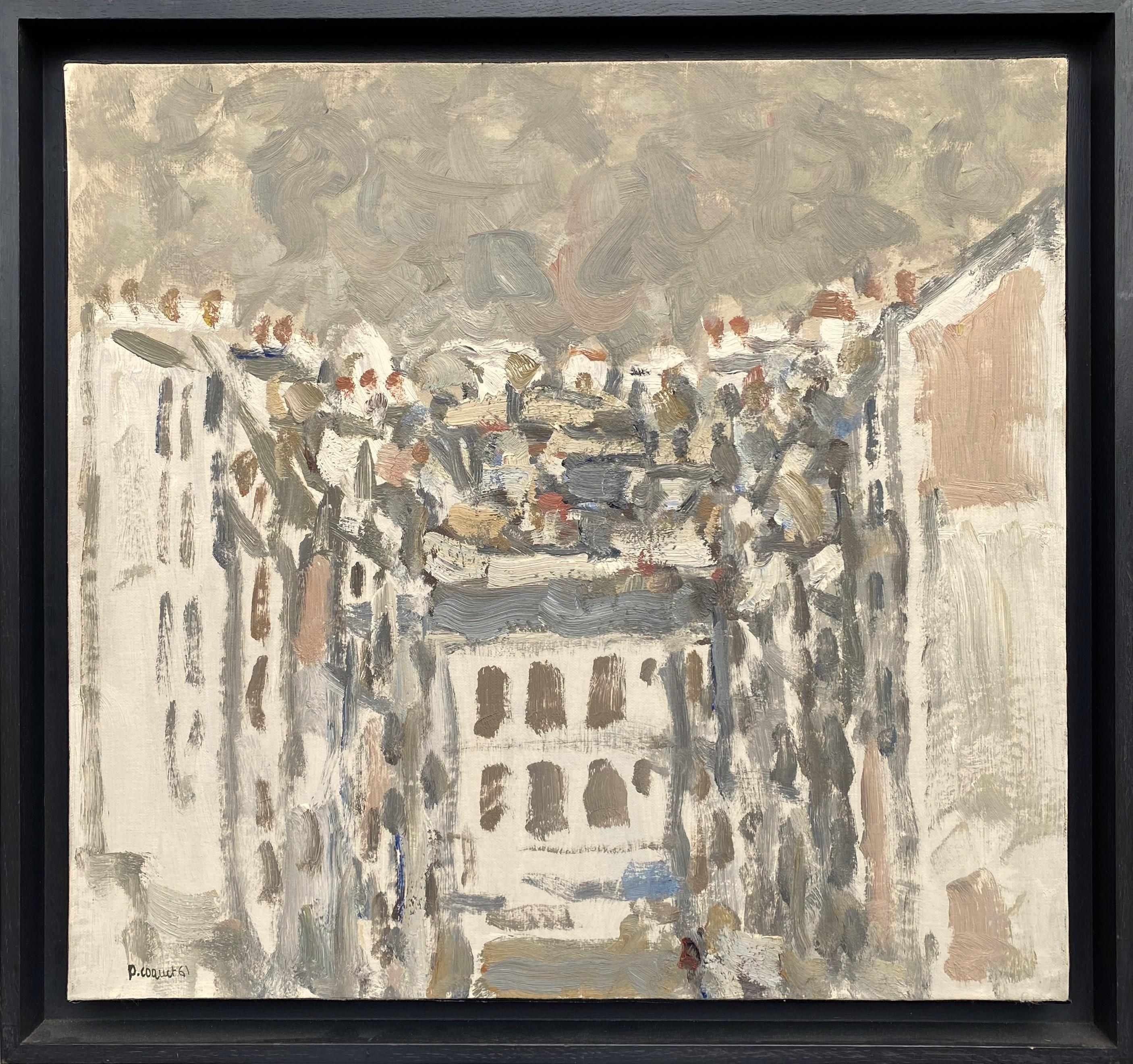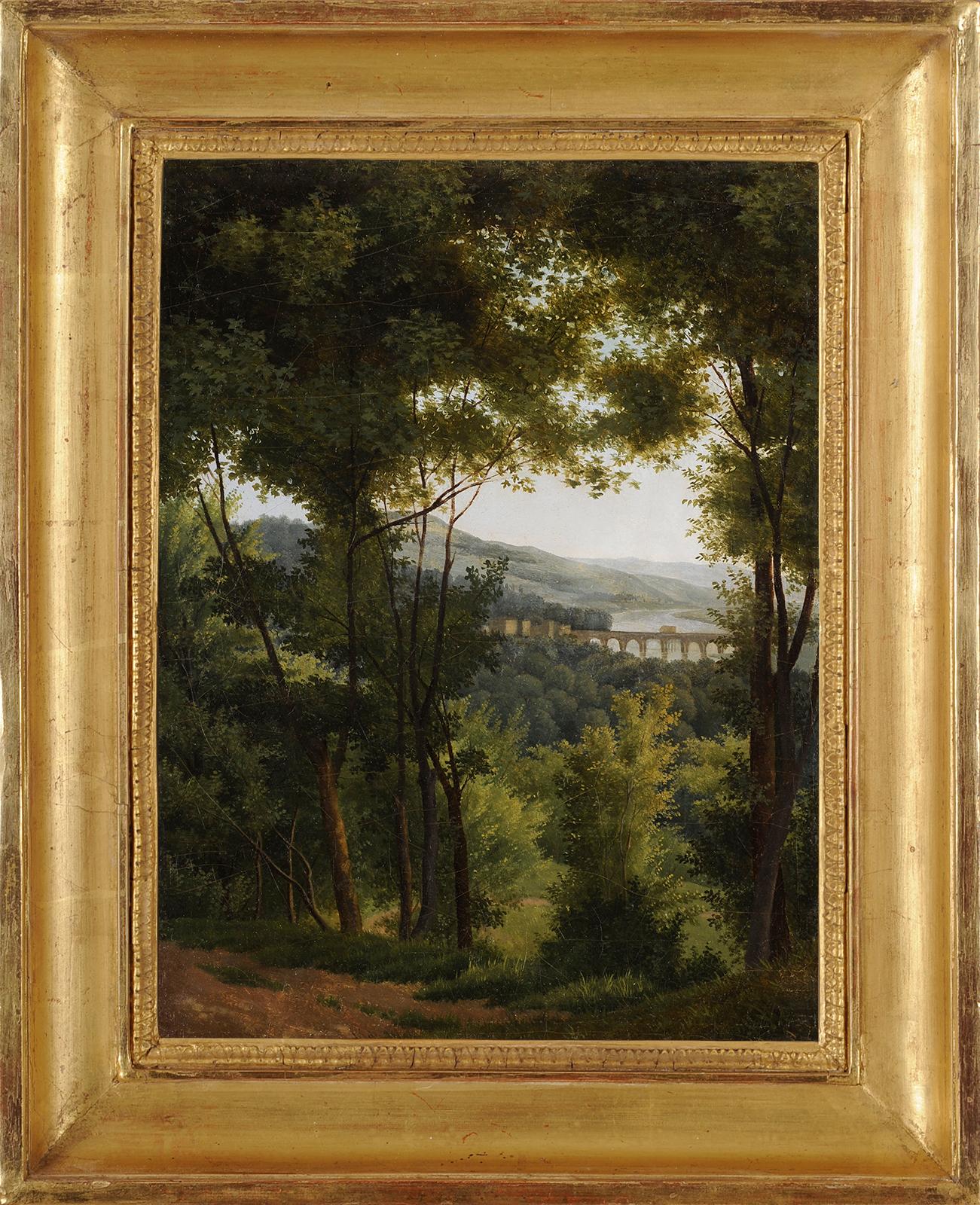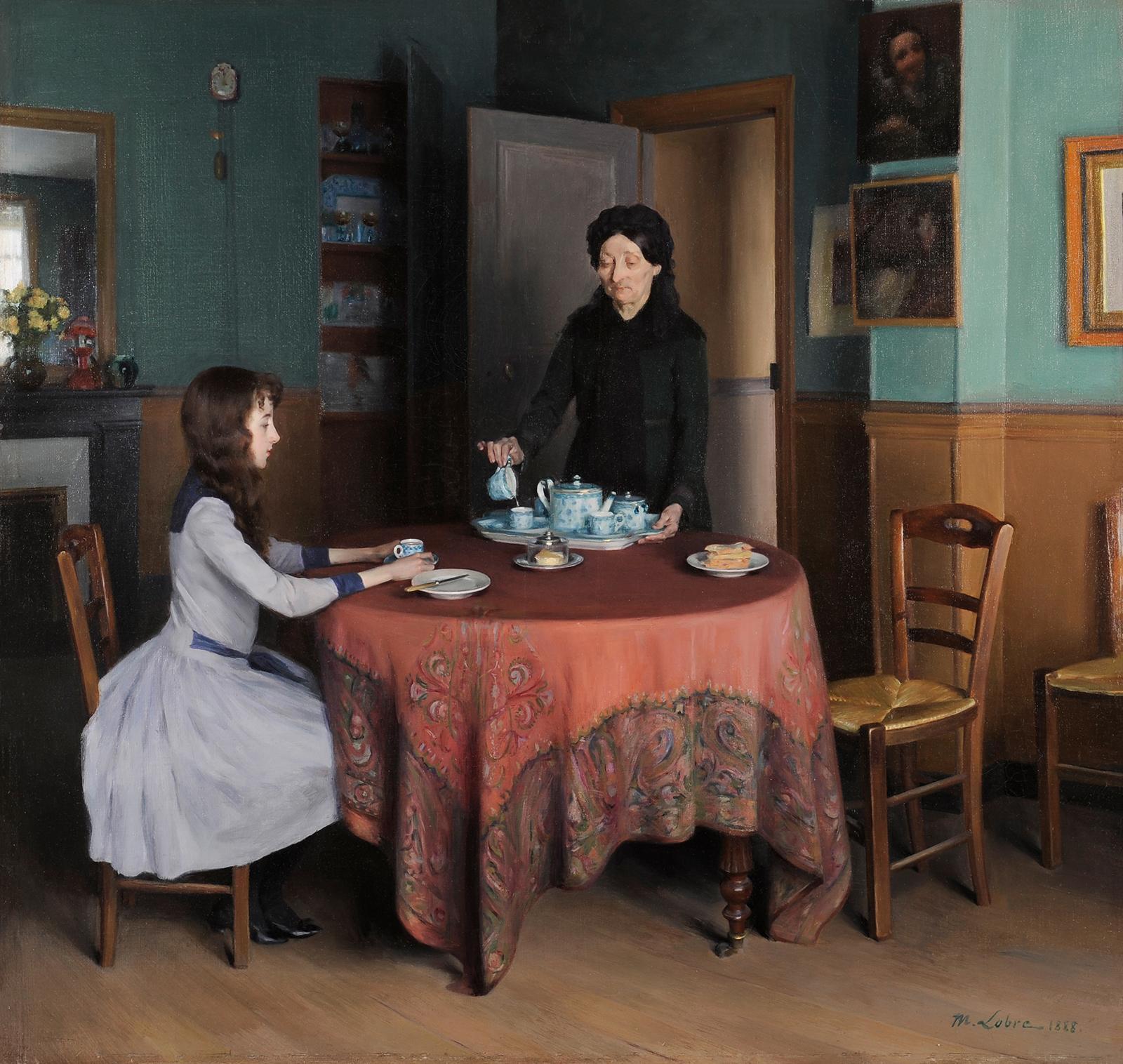Items Similar to Henri-Jean Chasselat, Town Scene With Buildings, Horse, Wagon & Figures
Want more images or videos?
Request additional images or videos from the seller
1 of 13
Henri-Jean ChasselatHenri-Jean Chasselat, Town Scene With Buildings, Horse, Wagon & Figuresc. 1860
c. 1860
About the Item
This mid-19th-century oil painting by French artist Henri-Jean Chasselat (1813-1880) depicts a continental town scene.
Four white horses, hitched to a covered wagon, wait patiently at a crossroads for their driver to return. Around them, an assortment of ramshackle buildings, each unique from the next. Several are probably centuries old given their unusual architecture and timber-framed facades. On the left, a particularly interesting building features a ‘jetty’ projecting above the lower floor - it’s covered in climbing flora. While on the right, there’s a prominent turret with a tiled conical roof.
Chasselat was a classically-minded Parisian who often looked back to the old masters for inspiration. With this in mind, could this be an untouched historic suburb of the French capital? During the 1860s, Paris underwent a sizable transformation - did he capture it for posterity? The overcast, brooding, low-lying clouds bring an ominous sense of foreboding.
A fine work by an accomplished hand.
Signed/dated lower left and held within a wooden frame.
Provenance: Private collection, Germany.
Artist’s auction maximum: £14,000
- Creator:Henri-Jean Chasselat (1813 - 1880, French)
- Creation Year:c. 1860
- Dimensions:Height: 23.5 in (59.69 cm)Width: 29.5 in (74.93 cm)
- Medium:
- Movement & Style:
- Period:
- Condition:Artwork presents well. Craquelure but the paint is stable. Canvas relined. Later stretcher. Frame with some light wear.
- Gallery Location:Cheltenham, GB
- Reference Number:1stDibs: LU2328213173452
About the Seller
5.0
Platinum Seller
These expertly vetted sellers are 1stDibs' most experienced sellers and are rated highest by our customers.
Established in 2017
1stDibs seller since 2023
132 sales on 1stDibs
Typical response time: 1 hour
- ShippingRetrieving quote...Ships From: Cheltenham, United Kingdom
- Return PolicyA return for this item may be initiated within 14 days of delivery.
More From This SellerView All
- John White, The Big One, Oil PaintingBy John WhiteLocated in Cheltenham, GBThis late 19th-century oil painting by Scottish artist John White (1851-1933) depicts a boy fishing in a stream with the sea beyond. With his line taut, he leans back and looks opti...Category
1880s English School Landscape Paintings
MaterialsCanvas, Oil
- Arthur Ellis, Children In A Cornfield, Oil PaintingBy Arthur EllisLocated in Cheltenham, GBThis beautiful early 20th-century oil painting by British artist Arthur Ellis (1856-1918) depicts children in a cornfield before a distant view of the sea. Ellis was first and forem...Category
Early 1900s Impressionist Landscape Paintings
MaterialsCanvas, Oil
- Nils Kjellberg, The Sower, Antique Oil PaintingLocated in Cheltenham, GBThis early 20th-century post-impressionist oil painting by Swedish artist Nils Kjellberg (1871-1938) depicts a field worker sowing the land. It’s inspired by Jean-François Millet’s w...Category
1910s Post-Impressionist Figurative Paintings
MaterialsCanvas, Oil
- Peter Tom-Petersen, View From Brahetrolleborg, Oil PaintingBy Peter Tom-PetersenLocated in Cheltenham, GBThis early 20th-century oil painting by Danish artist Peter Tom-Petersen (1861-1926) depicts a view on the Brahetrolleborg estate. Beyond a fence with climbing rose bushes, three me...Category
Early 1900s Naturalistic Landscape Paintings
MaterialsCanvas, Oil
- Victor Forssell, River Landscape With Cottages, Oil PaintingLocated in Cheltenham, GBThis spirited 19th-century oil painting by Swedish artist Victor Forssell (1846-1931) depicts a river landscape with cottages and figure. Painted in 1...Category
1870s Realist Landscape Paintings
MaterialsCanvas, Oil
- Ludvig Luplau Janssen, Children Dancing In A Forest Glade, Antique Oil PaintingLocated in Cheltenham, GBThis early 20th-century oil painting by Danish artist Ludvig Luplau Janssen (1869-1927) depicts two children dancing in a forest glade. A mother, seated upon a circular tree bench i...Category
Early 1900s Impressionist Figurative Paintings
MaterialsOil, Canvas
You May Also Like
- View of Paris, oil painting by Pierre CoquetLocated in Montfort l’Amaury, FRReference number F367 The painting is framed with a dark grey wood floated frame. 50 x 53 cm frame included (45 x 48 cm without frame) This work is painted with oil on a canvas. It i...Category
1960s French School Figurative Paintings
MaterialsCanvas, Oil
- View taken in the Park of Saint-Cloud near ParisLocated in BELEYMAS, FRAlexandre-Hyacinthe DUNOUY (Paris, 1757 – Jouy en Josas, 1841) View taken in the park of Saint-Cloud Oil on paper mounted on canvas H. 31.5 cm; L. 24 cm Around 1820 Provenance: -Per...Category
1810s French School Figurative Paintings
MaterialsCanvas, Oil
- Mediterranean shore, probably the French RivieraLocated in BELEYMAS, FRJean-Baptiste-Arthur CALAME (Geneva, 1843 - Geneva, 1919) Mediterranean shore, probably the Côte d'Azur Oil on canvas mounted on cardboard H. 24 cm; L. 30 cm Signed lower right Circa...Category
1870s French School Figurative Paintings
MaterialsCanvas, Oil
- A Mythological Scene, Early 1700s, Oil on CanvasLocated in Stockholm, SEThis exquisite painting, attributed to the circle of Charles Antoine Coypel, presents a mythological scene. Though the artist remains unknown, the work clearly echoes the style of th...Category
Early 18th Century French School Figurative Paintings
MaterialsCanvas, Oil
- View of Châteaudun castle and city in FranceLocated in BELEYMAS, FRFrançois-Edme RICOIS (Courtalain, 1795 - Mareil-Marly, 1881) View of Châteaudun Oil on canvas H. 65 cm; W. 98 cm Signed and dated lower center 1860 François-Edme Ricois although bor...Category
1840s French School Figurative Paintings
MaterialsCanvas, Oil
- Maurice Lobre (1862 -1951) The snackBy Maurice LobreLocated in BELEYMAS, FRMaurice LOBRE (Bordeaux 1862 - Paris 1951) Le goûter Huile sur toile H. 87 cm ; L. 91,5 cm Format peint d’origine, H. 101 cm ; L. 96 cm, disposé sur un châssis plus petit par l’artiste lui-même. Signée et datée 1888 en bas à droite Provenance : Collection privée, Lyon Exposition : 1889, Salon des Artistes Français, n°1719 « Intérieur », (ou 1720 nommé également « Intérieur ») Œuvres en rapport : Le Cabinet de toilette de Jacques-Emile Blanche, (titre erroné) H. 80 cm ; L. 85 cm, HST, Museo Thyssen-Bornemisza, Madrid, pendant de notre toile. Maurice Lobre a-t-il connu Marcel Proust ? On ne peut encore l'affirmer, bien qu'il ait eu de nombreux amis en commun avec l'écrivain. Mais sa peinture intimiste pourrait illustrer certaines pages de Du côté de chez Swann. Trois citations dues à des proches de Proust, l'une de l'écrivain Léon Daudet, la seconde du peintre Jacques-Emile Blanche, la dernière du poète mondain Robert de Montesquiou, donnent un aperçu de ce que fut la renommée de Maurice Lobre en son temps : "Il en va autrement de Lobre, le Vermeer français, le peintre exquis des intérieurs et des palais de Versailles, des reflets sur les meubles rares, de la lumière prisonnière des miroirs, des laques et des cuivres polis. Lobre est joyeux comme un coup de vent, qui fait envoler les préjugés et les poncifs, éloquent, passionné, ivre de la couleur et des formes, charmant et conquérant de toutes les matières. Il se promène ici-bas ainsi que dans un musée en plein-air, s'amuse de tout, rejette et maudit le laid et le vil, accueille et bénit le beau et le bien…" Léon Daudet L'Entre-deux-guerres. Souvenirs des milieux littéraires, politiques, artistiques et médicaux de 1880 à 1905. "Voici le patient, appliqué, sage M. Lobre. Il est difficile de mettre plus d'honnêteté à peindre des intérieurs sans figures. Je préfère ses petits salons de Versailles à ses cathédrales… Nous lui devons des petits bijoux d'émotion et de large fini." Jacques-Emile Blanche "Il a recueilli sur des toiles le visage du vieux Versailles (…). Il a peuplé de visions impalpables des chambres " où il s'est passé quelque chose ", et il en a saturé l'atmosphère de particules historiques. Donner une telle impression avec certitude, avec vérité, c'est plus difficile que de faire évoluer des personnages costumés, dans ce qu'on appelle bêtement "une reconstitution historique"." Comte Robert de Montesquiou Maurice Lobre commence sa carrière au Salon de 1882 où il expose deux portraits, dont celui de son camarade de l'atelier Carolus-Duran, le peintre espagnol Ramon Casas...Category
1880s French School Figurative Paintings
MaterialsCanvas, Oil
Recently Viewed
View AllMore Ways To Browse
Hand Painted Horse Painting
Timber Art
Fine Art Parisian Painting
Country Horse Paintings
Used Wagons
Horse Painting Old Masters
Old Safes
Horses Scene Oil Painting Antique
Antique Horse Cover
Canadian Old Masters
Crossroads Painting
Climbing Frame
Brave Fine Art
Antique German Horse
Antique Timber Frames
19th Century French Country Scene
Antique Building Facade
Low Country Painting





